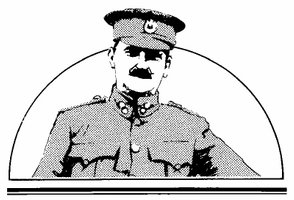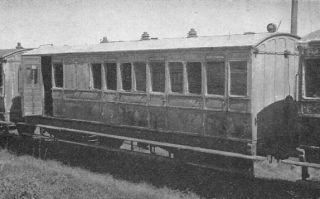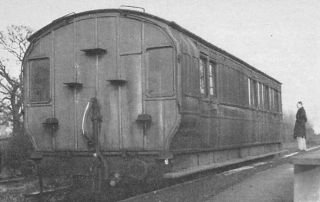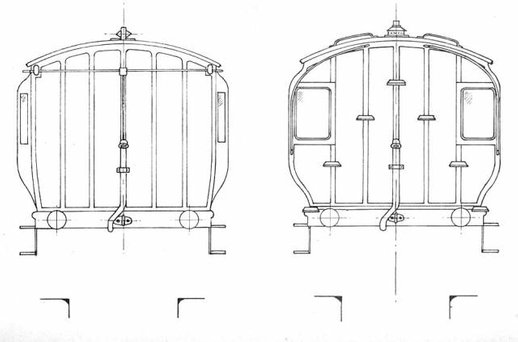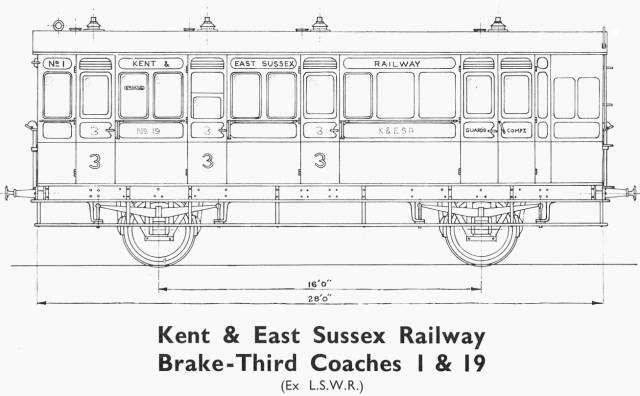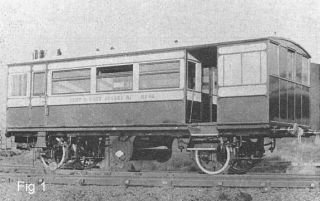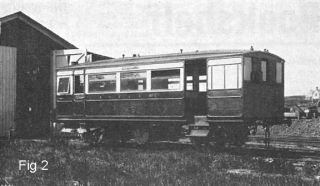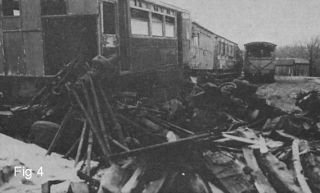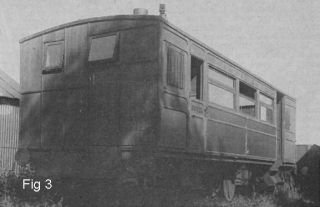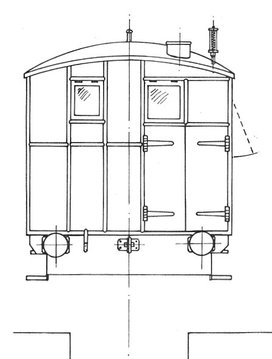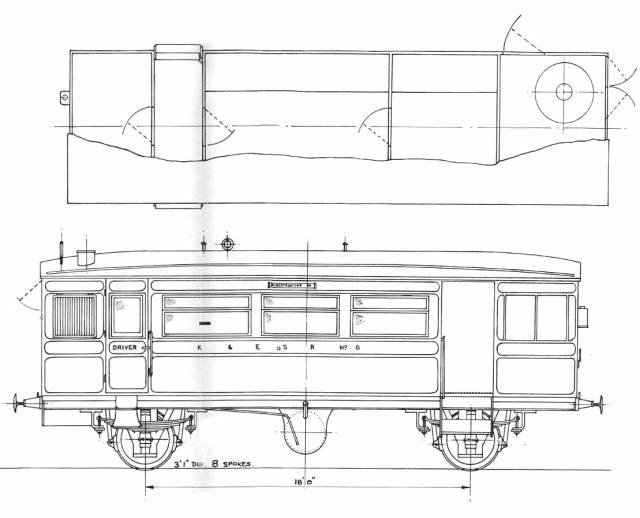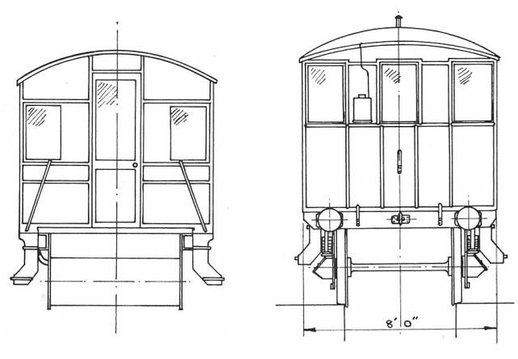Light Railway Modelling
Kent & East Sussex Light Railway - passenger stock
Les Darbyshire
COLONEL STEPHENS seems to have been rather partial to ex L.S.W.R. coaches on his various light railways, most of them having had at least one at some time. The Kent and East Sussex certainly specialised in them, having had at least ten different ones in the course of its history. This month we deal with the two oldest of these, four-wheelers dating from the 1880's. They were three-compartment brake thirds of a type common on local and suburban lines of the period.
Their date of purchase is not known with any certainty: both could have come in 1952, though one reference gives 1932 as the date for one of them. It is possible that there were more than two of them, so both dates could be correct. The history (and numbering) of K. & E.S.R. coaches is very obscure, though this probably will not worry most modellers unduly. Certainly, in 1935 there were only two, numbered 1 and 19.
They were identical apart from their livery, in which they were completely different. No.1 was painted dark green (described as "bottle green"), with large white figures on the doors and white lettering along the upper panels. No. 19, however, was chocolate ("plain" rather than "milk") with yellow lettering and class numbers on the waist panels, though this livery was rather faded and "tatty" compared with No. 1 which then had been newly painted.
The coaches were used as spares, and usually were only brought out on special occasions such as for hop pickers' trains, when anything that could move was pressed into service. They survived until the end of the independent existence of the line, being finally broken up in 1948 after Nationalisation, when 4-wheeled coaches were definitely frowned upon.
The K. & E.S.R. also possessed a very similar L.S.W.R. 6-wheeled three compartment brake-third, as shown in the second photograph. Its length was believed to be 32 ft., with a 20 ft. wheelbase. The extra length was taken up by a much longer van, there being six panels (slightly narrower than those on the 4-wheeler) between the compartments and the guard's double doors. If any reader can confirm these dimensions, and also provide the number of this coach, I would be most grateful.
Now for modelling. Some years ago I built an "EM" model of No. 1, using Bristol board for the sides, I mm. plywood for the ends and partitions and 1/8 in. Obechi for the floor and false roof. The roof proper was card about 1/32 in. thick, and notepaper was used for panelling. Now, I would use "Plastikard" as the basic material and build the model in half the time with probably a better finish into the bargain! In 0 gauge also, Plastikard would be a good bet for the sides and ends, though 1mm. plywood would be a reasonable alternative. Wheels of the Mansell pattern, and axleguards which are a reasonable approximation can be obtained commercially in both scales, as can the lamp tops.
Pickering Steam Railcar
In the early years of the twentieth century, railways in this country were facing intense competition on suburban routes from electric tramways which were then becoming very widespread and popular. In order to reduce their losses, the railways had to find a way to reduce operating expenses and increase the frequency of services. The solution was the steam railcar, a self-contained vehicle which contained both power plant and passenger accommodation.
The first successful railcar of this type was designed by Drummond of mthe London and South Western Railway and entered service on the joint Fratton - ¬East Southsea branch in 1903. The idea soon spread, and over the next few years steam railcars were being used by most of the main line companies both for suburban services and for rural branch lines which, even seventy years ago, were running at a loss. Most of these railcars were eight wheeled, the engine portion being usually a 2-2-0 or 0-4-0 and the coach portion supported partly by the engine and partly on an ordinary four wheeled bogie. The subject of this month's drawing, however, was rather smaller, having only four wheels and was built by R.Y. Pickering and Co. for the Kent and East Sussex Railway in 1934, entering service in 1935.
Very little information seems to have survived about this vehicle, and the drawing was made largely by projection from photographs, with the help of a couple of known dimensions. Its accuracy, like that of some other subjects of this series, cannot therefore be guaranteed. The car was very similar in construction to the contemporary bogie coaches from the same manufacturer described in the January issue, and it has been assumed that such dimensions as body height and width were identical. The wheels are quoted in various publications as being 3 ft. 6 in. diameter, but care¬ful scaling from the photographs shows that they were smaller than this, and were probably 3ft. 1in., the usual Pickering coach size.
At one end of the car was the driving compartment containing a vertical boiler and a two-cylinder engine with 5½ x 6 in. cylinders driving the leading axle through a chain and sprockets. The layout of engine and drive is not known. The central passenger section was reached by a door from a transverse vestibule, open at both sides and entered by steps. A partition divided the passenger section into smoking and non-smoking compart¬ments, which are believed to have had seats along the sides. At the rear of the vehicle, and also reached from the vestibule, was another driving compartment which was presumably also used for luggage. A cylindrical water tank was slung transversely under the body, but it is not clear where coal was stored or how it was taken aboard.
The passenger compartment was ventilated by inward-hinged top-lights above the windows as on the Pickering bogie coaches, this system being augmented by a torpedo ventilator above the smoking com¬partment. Lighting was by acetylene. A hinged, slatted panel ventilated the engine compartment on the nearside, though whether a similar one existed on the offside is not known as all my photographs were taken from the same side. The end of the engine compartment had two small windows which hinged out¬wards and upwards, and a pair of doors giving access to the boiler. These features, seen in Fig. 3, look such a "bodge-up" that they may well not be original, but I have no early photograph showing that end. The other end had three windows, the centre one being a droplight, and had a much neater appearance.
When delivered, the railcar was numbered 16, presumably in the carriage stock series, painted choco¬late and cream and lettered as shown in Fig. 1. Later, the livery was slightly changed as seen in Fig. 2, the number being changed to 6 in the locomotive series. This must have been done before 1910, when the “Ilfracombe Goods” No. 7 was acquired. Later still, the livery was probably changed to buff all over. It is not known how long the vehicle ran in service; I have never seen a photograph of it actually in use. It lay for many years on the "dump" sidings behind Rolvenden shed, where it can be seen in Fig. 4, taken in 1939. It is believed to have been sold for scrap in 1941.
Now for the model. The body would present no real problems apart from some tricky panelling. Spoked wagon wheels would be ideal for size and number of spokes, and the motor could drive the front axle - no need to model the chain drive unless you're very keen! As the car only has to propel its own weight, a small motor could be used mounted vertically in the engine compart¬ment, leaving the passenger com¬partment completely free. A metal chassis would be preferable with perhaps some ballast at the back to counterbalance the weight of the motor.
The real beauty of modelling a railcar such as this is that it is completely self contained: a loco¬motive needs something to pull and a coach or wagon something to pull it, but a railcar is complete in its own right and is therefore, ideal as a first vehicle for a new layout. One word of warning, however; the eighteen-foot wheelbase probably won't like sharp curves, so make up a crude test chassis to run round your layout before you start building, or you may find you've built a model you can't run !
